Australian Fugitive Methane Reduction: a case study for coal mining
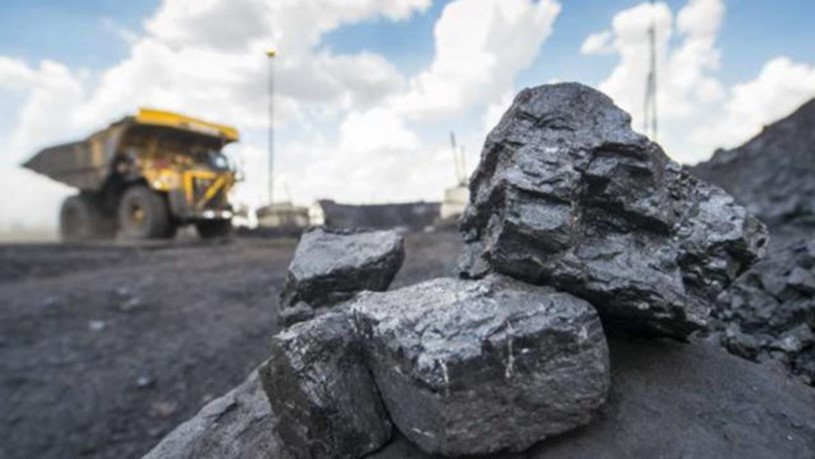
The Australian mining industry leads the world in introducing new innovative technology like automated trucks and driverless trains.
The latest topic in mining decarbonisation, fugitive methane, poses a unique and significant opportunity for the coal sector to reduce its carbon footprint and the impacts of climate change. This paper discusses the drivers for a renewed effort from the coal sector and highlights the expansion challenges.
Fugitive emissions are a large contributor to Australia’s mining industry greenhouse gas (GHG) footprint. This is due to the high climate change impact of methane, and the scale of the coal mining industry. Mine owners and governments can expect increasing pressure from host communities and international markets to expand reduction efforts.
Today, there are several commercial technologies and arrangements to reduce fugitive emissions, but more can and should be done. It is important to establish an understanding of the facts, the current solutions, and potential solutions in development. A combination of expanded pre-drainage practices, commercialising Vent Air Methane (VAM) abatement technology, and carbon prices will enable these fugitive technology investments to become economically viable.
Ultimately, we recommend all coal mines (underground and open cut) to consider expanding fugitive reduction technology, seeking support from research and investors, and planning to avoid future liability.
1. The Australian coal industry has a fugitive methane opportunity
Fugitive emissions refer to the release of Greenhouse Gases (GHGs) from mining, oil and gas extraction and other industrial processes. In the coal mining context, methane from coal seams can escape during the mining processes of both underground and open cut operations. Methane naturally occurs within coal seams after being trapped during their formation. Deep coal deposits are formed with high temperature and high pressure, and therefore produce greater volumes of gas. In comparison, shallower coal deposits traditionally produce lesser volumes of gas.
Why is fugitive methane an opportunity for the Australian coal mining industry in particular?
There are three primary reasons: the sizeable climate change impact of methane is becoming more apparent, the percentage of methane emissions from coal mining is significant, and emissions from mining will affect social licence to operate. These will be discussed in the sections below.
1.1. Methane’s high climate change impact is becoming more visible
Methane has a greater impact on climate change than carbon dioxide [1]. Scientists use a scale of Global Warming Potential (GWP) to compare the warming impact of different gases in the atmosphere. The GWP tells us that methane (CH4) has 28 times the impact of carbon dioxide (CO2), on a long term 100-year time frame [2]. As a result, global emissions are often quoted in carbon dioxide equivalent emissions (CO2-e) and methane represents a fifth of all global emissions on this basis.
A key difference between methane and carbon dioxide is atmospheric half-life. Methane only lasts in the atmosphere for around 10 to 15 years as compared to carbon dioxide, which can last for up to 1000 years [3]. Therefore, action taken now to permanently cut methane emissions will yield quick drops in the total level of GHG emissions in the atmosphere. If we imagine our journey to prevent climate change as steering to avoid a Titanic-style iceberg, addressing methane emissions will give us a much bigger steering wheel and tighter turning circle than carbon dioxide.

Given the above importance of methane, scientists, governments, and companies continue to improve the accuracy of measuring methane from fugitive emissions. The most significant step in monitoring methane has come from the European Space Agency (ESA). ESA announced at the COP26 conference (United Nations Conference of the Parties (COP) conference, last held in Glasgow, Scotland in November 2021) that they have a new mission to map anthropogenic emissions via satellites. These satellites will focus on the two major GHGs, carbon dioxide and methane, and provide near real time and detailed reporting for each major part of the globe [4]. The next three satellites (GHG Sat-C3 to C5) are expected to bring the total satellites in orbit to ten by 2023, providing ground resolution as low as 25-50 m. This will allow the detection and quantification of point sources as small as individual oil and gas wells, and coal mines [5].
What does this mean for the coal mining industry? Stakeholders will have greater access to more accurate public emissions data – the exact emissions for each site and whether efforts are being made to change over time. There will also be less reliance on company supplied data.
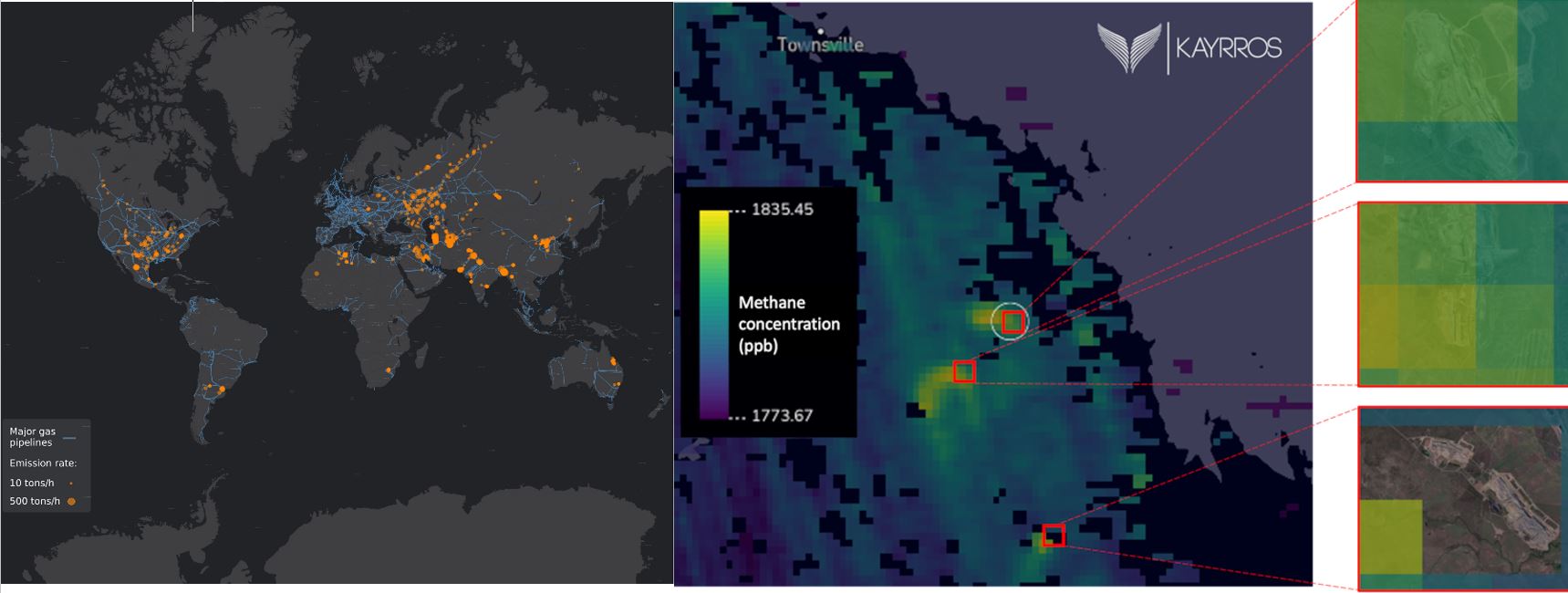
1.2. Overall contribution of fugitive methane is significant
Each year, the Australian mining industry is estimated to produce 57 Mt (Million tonnes) CO2-e or almost 11 per cent of Australia’s total 2020 emissions. Of this total, about 44 Mt comes from coal mining alone [7]. The bulk of coal emissions come from fugitive emissions from underground and open cut coal mining, as shown in the chart below.

Some research has suggested that fugitive emissions from coal mining will continue for 100 years after the closure of existing mines [1]. This makes tackling fugitive emissions a priority for Australia’s current and future governments and companies. This topic will become more relevant and pressing over time, as net zero targets approach and carbon pricing becomes more widespread.
1.3. Emissions will affect social license to operate
The Australian mining industry is a large contributor to the Australian economy. In 2019 it accounted for approximately 60 per cent of export merchandise and 12 per cent of Gross Domestic Product (GDP). The coal mining industry itself employed approximately 38,100 people as of FY2018 [8] and black coal provided about 27 per cent of export earnings [9]. Hatch estimates that about 80 per cent of Australia’s coal or 360 Mt comes from open cut mining, and 20 per cent or 90 Mt from underground [7]. The chart below shows most coal mining activity is focused on Eastern Australia.
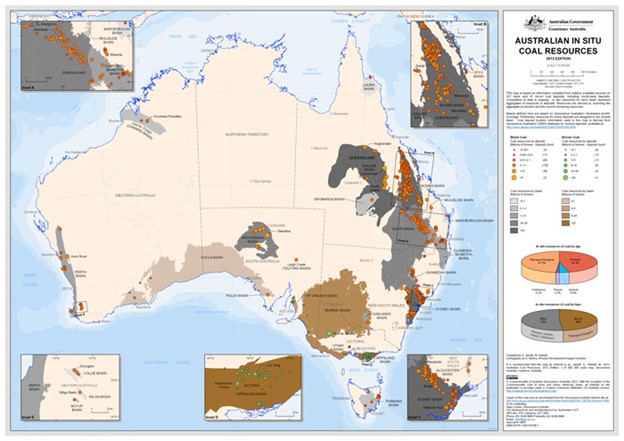
Coal mining will continue to contribute to Australia’s economic future in the near term, but only if the industry maintains its social licence to operate. The CSIRO's Australian National Outlook 2019 reported that in the mining industry, ‘failure to earn and maintain community support and approval could reduce the market value of a project by up to 70 per cent’ [10]. Furthermore, a survey of 150 global mining companies in 2020 found that 44 per cent cited social licence to operate as the number one risk to their business [11].
Climate change remains a priority in the minds of both Australians and our international trading partners. If coal mining is to continue providing numerous benefits to the Australian economy, then it is imperative that the industry protect its social licence.
2. How will the industry reduce fugitive emissions?
2.1. Several processes for gas drainage are mature
Methane is extracted in three stages of coal mining:
- Pre-mining: Methane is often drained prior to its liberation during the mining process; for safety and occasionally economic reasons. In terms of safety, the primary concern is that methane is explosive in concentrations as low as 5-15 per cent in air [12].
- During mining: This phase includes further pre-drainage as the mine expands, and ventilation air methane (VAM) capture in underground mining only. For both open cut and underground mining, residual methane in coal seams cannot be completely captured, resulting in fugitive emissions which currently enter the atmosphere.
- Post mining: Techniques only apply to underground coal mining and involve methods such as goaf (i.e. the part of the mine from which the mineral has been partially or completely removed) drainage via directional drilling and the sealing of old mine workings to prevent methane leakage.
Once methane is extracted, there are three possible options for handling it:
- Flaring, or combustion: Eliminates the high Global Warming Potential (GWP) of methane by converting it to carbon dioxide. Effectively, this reduces the GWP of these emissions by a factor of 28 if the methane is 100 per cent combusted.
- Utilisation as natural gas or for power generation: This converts the methane to mobile vehicle fuel, or for heating or electricity value. Emissions are effectively converted from the mine operator’s Scope 1 to Scope 3 (Scope 1 emissions refer to fuel and gas emissions sources directly within the operating area of a site. Scope 2 refers to emissions incurred in providing electricity, steam, heat, or cooling to the site. Scope 3 refers to gas emitted at either the suppliers of materials, or the downstream customers of a site’s products). Under this option, the emissions are now the responsibility of a separate end-user.
- Sequestration: The best solution from a climate change perspective place captured methane or carbon dioxide into long term storage or usage.
As an industry, the focus for future operations should be to reduce the flaring of captured methane, and switch to better uses such as energy or chemical production. An example is the arrangement between Arrow Energy and Anglo American, where Arrow supplies drilling and drainage services to Anglo to capture and utilise methane. The captured methane is then sold to either gas power producers like EDL or injected into domestic and LNG gas supply chains. Although CO2 from natural gas combustion also has a climate change impact, using this fugitive methane displaces natural gas that would otherwise be extracted from other sources.
An example of the broad categories of fugitive emission reduction technologies is shown in Figure 2.1-1 for both underground and open cut coal mine operations.
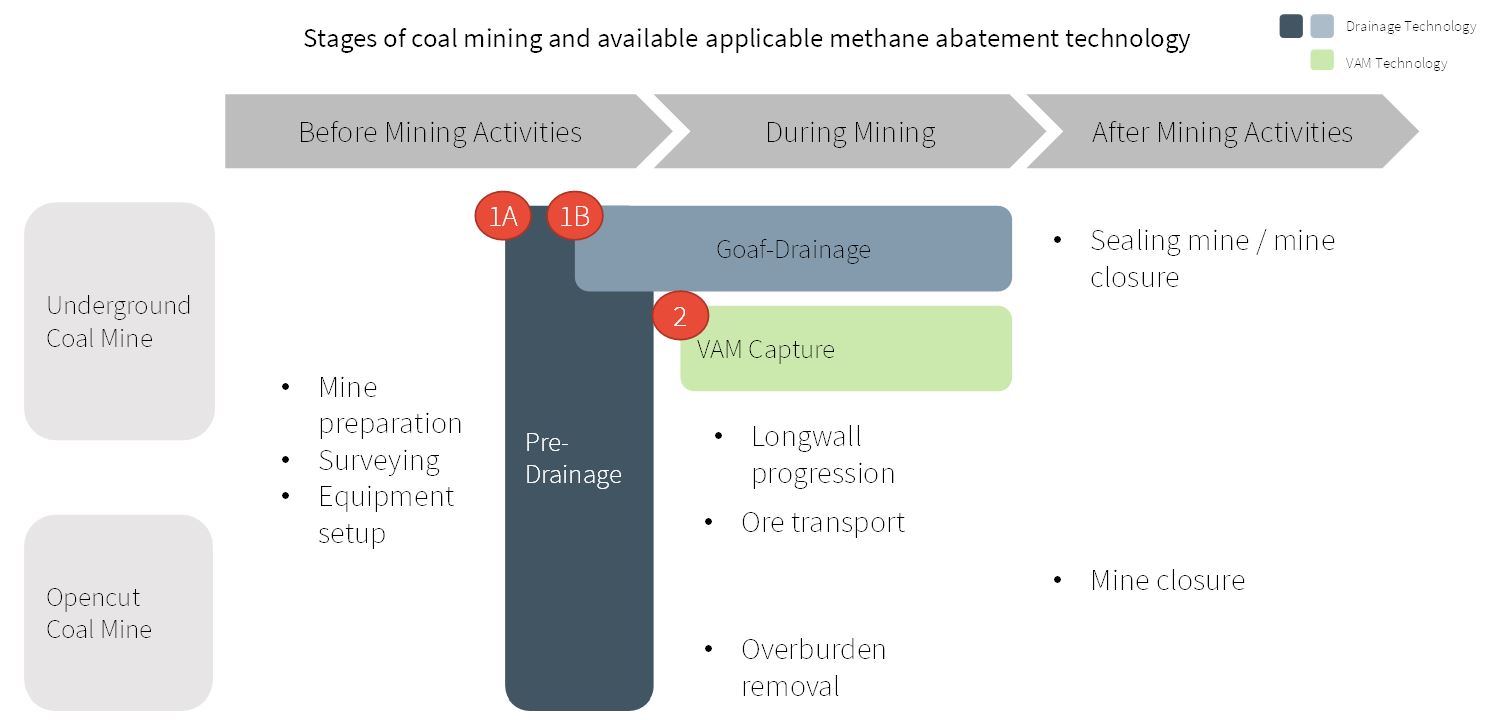
Figure 2.1-1 shows (1A) Pre-Drainage and (1B) Goaf-Drainage as a combination of related drainage activities, as shown graphically on the next page. (2) VAM Capture is a separate system due to the low methane concentration and high air volume.
The absence of technologies to capture fugitive methane once opencut mining has commenced is because almost all methane is released instantly during blasting.
The difference in fugitive emissions abatement technology between underground and opencut mines can also be described graphically in Figure 2.1-2.
Underground Mining Fugitive Methane
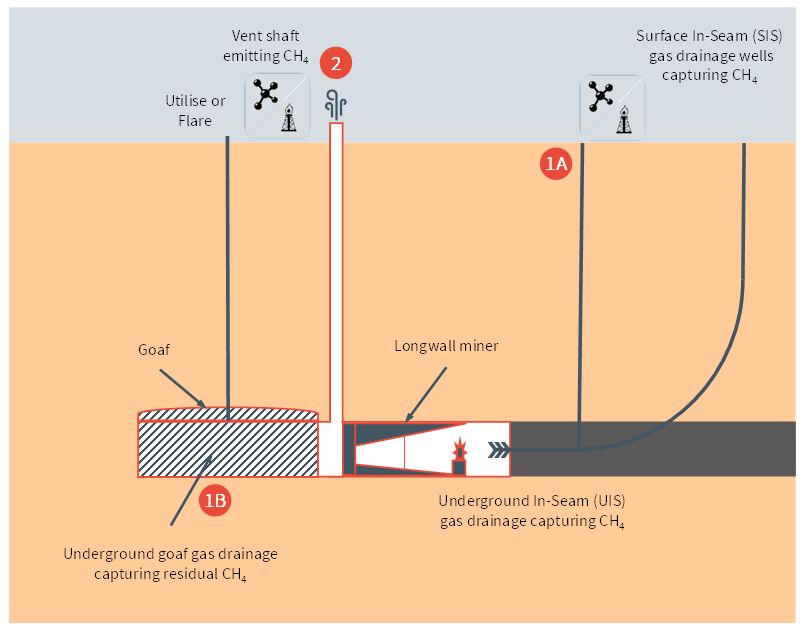
Opencut Mining Fugitive Methane
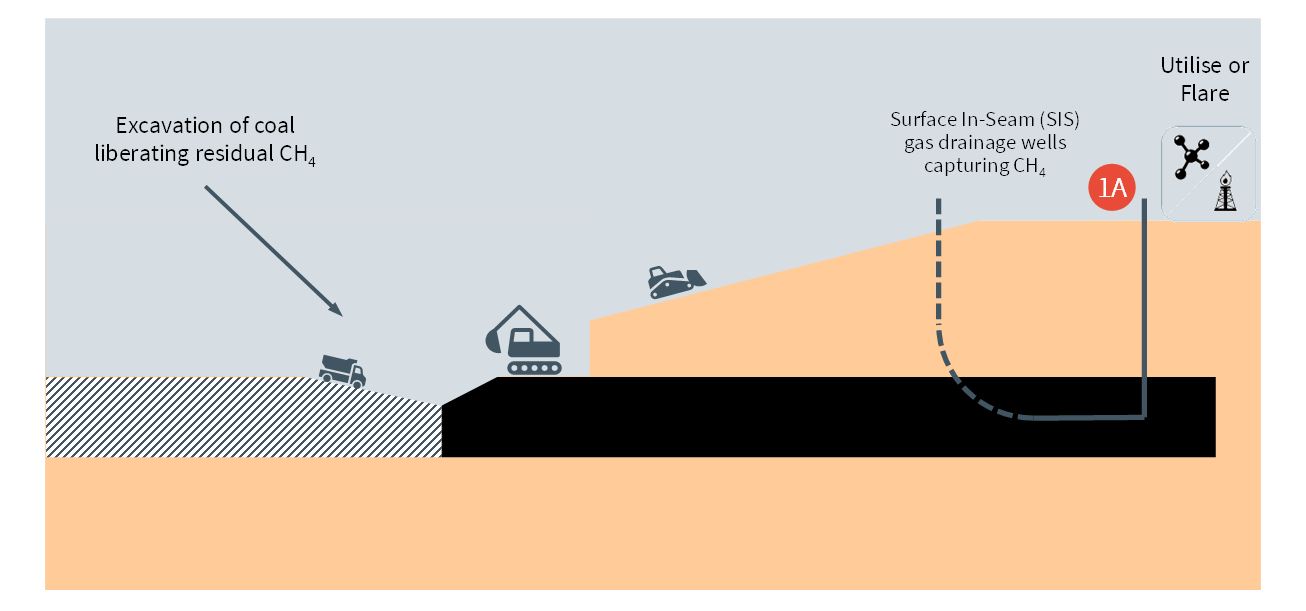
Experience of a commercial arrangement with the gas producer, Arrow Energy, provides a comparison of pre-drainage and VAM techniques in relation to their methane mitigation volumes and unit cost [13]. The graph highlights that methane is best captured prior to mining and becomes more expensive with VAM technologies after the mine has opened. However, it is not possible to capture all methane through pre-mining gas drainage, so VAM technologies are necessary for further mitigation. The challenge with VAM technology is that costs are high.
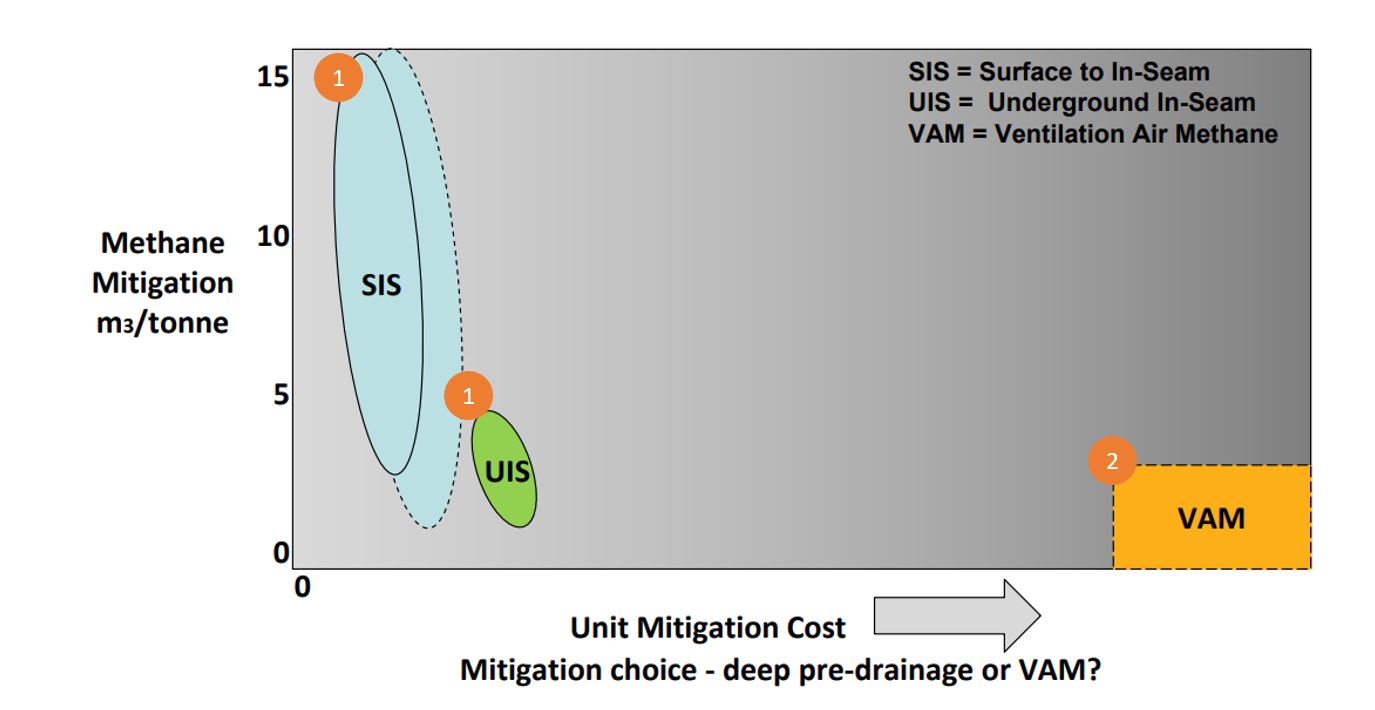
2.2 Status of technologies for methane capture to utilisation
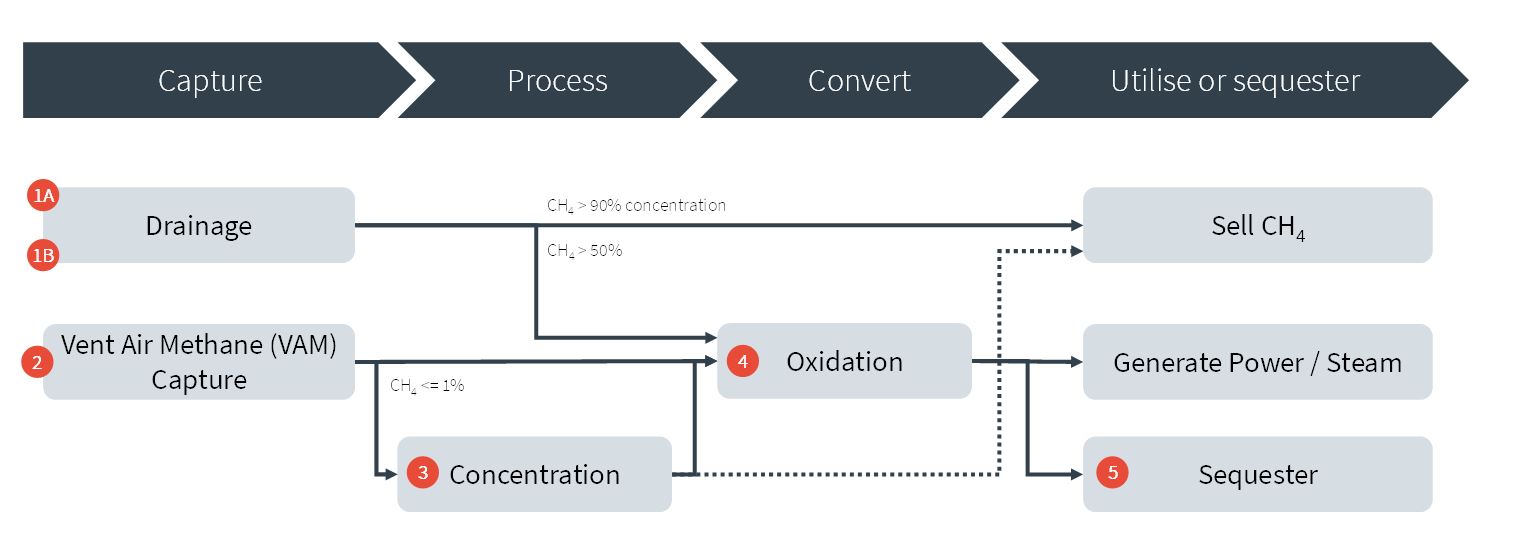
Figure 2.2-1 highlights the different types of technology relevant to fugitive methane. These can be described as follows:
- 1A/1B - Drainage includes drilling and well capture like the oil and gas industry. This is being conducted for most underground mines for economic and safety reasons.
- 2 – VAM Capture is capturing the underground mine ventilation air (containing methane), that is typically exhausted to atmosphere, and directing it to a downstream abatement technology. The challenge is ensuring as much VAM is captured without significantly impacting the underground mine ventilation system and safety.
- 3 - Concentration of VAM is not yet commercially available but is expected to be expensive and limited at scale based on gas separation technologies used in other industries.
- 4 – Oxidation includes multiple methods which aim to convert CH4 to CO2. Drainage gas, with higher CH4 concentrations, are typically oxidized with combustion technologies such as flaring or used for power generation. Oxidation of VAM is challenging due to the low concentration of CH4 (<1 per cent) and significant air volumes.
- 5 – Sequestration including methods to store the carbon from CH4 or CO2 in solid or liquid form such as the formation of calcium carbonate, CaCO3, or in additional products, like green concrete, glass, carbonated beverages etc. Green in this context means near zero or negative GHG by products during the production chain.
VAM abatement requires the combination of VAM capture and oxidation techniques. Additional sequestration or utilisation would improve the impact of fugitive emissions reduction [14] [15].
Regenerative Thermal Oxidation (RTO) is the only proven and commercially used technology for VAM abatement on a large scale and are currently implemented in the US and China. In Australia, there have been small scale RTO demonstrations for VAM abatement but it has not yet been adopted on a large scale. The high temperature operation of RTOs connected to underground coal mines present a risk of explosion and the RTO plants installed overseas do not satisfy the Australian mining standards and industry expectations for safety. Other oxidation technologies have been proposed and/or are currently being further developed for VAM. These include low temperature oxidation eg Regenerative Catalytic Oxidisers (RCO), chemical oxidation such as chemical looping, lean-fuel gas turbines and supplemental fuel in turbines, boilers, and internal combustion engines. Further research and development is needed to make these technologies viable for adoption in the industry.
It should be noted that containment technologies such as pressure balancing have been excluded. While these technologies do reduce the methane in VAM, the methane will be released post mining. Therefore, these are considered temporary forms of addressing methane.
2.3. Enablers for more fugitive reduction
Based on our experience, there are three main enablers and one external factor required for further fugitive methane reduction:
- Invest in decarbonisation technology for the long term - Australian coal mining companies should commit to decarbonisation by investing in more fugitive technology and the wider supply chain. This includes commercialisation efforts, in partnership with research organisations and governments. External investors will benefit from more transparency and technology certainty.
- Addressing the safety issues with methane oxidation – several VAM and oxidation technologies described in the above section are subject to strict mining safety regulation in Australia. Safety is paramount, yet there are lessons from existing US and China deployment that can be leveraged to maintain safe operation. Once addressed, VAM technology has a much higher likelihood of being implemented.
- Commercialising improved VAM abatement technology – current technologies are expensive, do not meet Australian mining safety standards or are still in the research and development phase. Therefore, these are not yet attractive for full-scale deployment.
- External factors – development of a true carbon price which places the current Australian Carbon Credit Unit price of A$53/t CO2-e (current price as at January 2022) as a cost trade-off. This could make fugitive methane capture costs relatively economic compared to the current optional offset cost or no cost for emitting methane.
3. Conclusion
Fugitive methane from coal mining contributes 32 Mt or almost six per cent to Australia’s national emissions. Yet, coal mining remains an important part of Australian exports and will be required for some time even as the world decarbonises. We have identified several enablers to allow Australian coal mining to reduce its fugitive emissions and thus contribute to addressing climate change.
First, all Australian coal mining companies should set realistic decarbonisation plans to aid in continuing social licence. This includes:
- Engage with the wider fugitive methane supply chain, including consultation with Government, research bodies, gas producers and gas users.
- Make full use of existing commercialised technologies, such as pre-drainage, before emissions are locked in.
- Continue their investment in developing existing VAM abatement technologies and new innovative methods.
A key piece of the puzzle remains the capital and operational expenditure of these fugitive methane reduction methods. In particular, VAM technologies for underground mines have high capital and operating costs in addition to safety restrictions not in line with other industries or economies. This can become a positive challenge to the industry like fast cost reduction of solar panels after 2000. Just as solar panel production became a key competitive advantage for China, low cost, safe and effective fugitive methane reduction can be a technological export for Australia.
There is no one ‘silver bullet’ technology in solving fugitive methane from coal mines. Instead, a decarbonisation roadmap that strategically outlines the implementation of current commercialised methods, combined with existing VAM technology and further investment towards innovating new techniques, is critical. This will enable the continued operation of Australian coal mines with a social licence and positive impact on climate change.
References
[1] ScienceDirect, “Global methane emissions from coal mining to continue growing even with declining coal production,” [Online]. Available: https://www.sciencedirect.com/science/article/pii/S0959652620305369. [Accessed 10 January 2022].
[2] Greenhouse Gas Protocol, “Global Warming Potential Values,” [Online]. Available: https://www.ghgprotocol.org/sites/default/files/ghgp/Global-Warming-Potential-Values%20%28Feb%2016%202016%29_1.pdf.
[3] A. Buis, “The Atmosphere: Getting a Handle on Carbon Dioxide,” NASA, 9 October 2019. [Online]. Available: https://climate.nasa.gov/news/2915/the-atmosphere-getting-a-handle-on-carbon-dioxide/. [Accessed 2022].
[4] COP26, “CAMS to help measure progress towards CO2 goals,” [Online]. Available: https://atmosphere.copernicus.eu/cop26-cams-help-measure-progress-towards-co2-goals. [Accessed 23 Jan 2022].
[5] European Space Agency, “GHGsat Overview,” [Online]. Available: https://earth.esa.int/eogateway/missions/ghgsat/description. [Accessed 23 January 2022].
[6] Kayrros, “Study provides first statistical characterisation of methane ultra-emitters from oil and gas,” 3 Feb 2022. [Online]. Available: https://phys.org/news/2022-02-statistical-characterisation-methane-ultra-emitters-oil.html. [Accessed Feb 2022].
[7] Hatch, “Confidential Client Project,” 2021.
[8] ABC News, “Are there really 54,000 people employed in thermal coal mining?,” [Online]. Available: https://www.abc.net.au/news/2019-07-11/fact-check-are-there-54000-jobs-in-thermal-coal-mining/11198150. [Accessed 23 January 2022].
[9] Australian Government: Geoscience Australia, “Value of Australian Mineral Exports,” [Online]. Available: https://www.ga.gov.au/digital-publication/aimr2020/value-of-australian-mineral-exports. [Accessed 10 January 2022].
[10] CSIRO, “How social licence is driving innovation in the mining industry,” [Online]. Available: https://www.csiro.au/en/work-with-us/industries/mining-resources/resourceful-magazine/issue-22/how-social-licence-is-driving-innovation-in-the-mining-industry. [Accessed 23 January 2022].
[11] Ernest and Young, “Top 10 Business Risks and Opportunities - 2020,” 5 February 2020. [Online]. Available: https://www.ey.com/en_gl/mining-metals/10-business-risks-facing-mining-and-metals. [Accessed 23 January 2022].
[12] CSIRO, “Emission Control Abatement,” [Online]. Available: https://www.csiro.au/en/work-with-us/industries/mining-resources/mining/fugitive-emissions-abatement. [Accessed 10 January 2022].
[13] Arrow Energy Pty Ltd, “Mine Pre-Drainage,” 2012.
[14] Australian Government Department of Industry, “Australian Coal Methane Abatement Projects Update GMI Coal Subcomittee 19th Session,” 3 June 2014. [Online]. Available: https://www.globalmethane.org/documents/news-item-440/2-Australia-060314.pdf. [Accessed Jan 2022].
[15] US EPA, “Ventilation Air Methane (VAM) Utilization Technologies,” July 2019. [Online]. Available: https://www.epa.gov/sites/default/files/2017-01/documents/vam_technologies-1-2017.pdf.pdf. [Accessed Jan 2022].
[16] Renewable Energy Club, “Carbon Market Price,” [Online]. Available: https://www.renewableenergyhub.com.au/market-prices/. [Accessed 23 January 2022].
[17] cleanenergyregulator.gov.au, “Coal mine waste gas,” [Online]. Available: http://www.cleanenergyregulator.gov.au/ERF/Pages/Choosing%20a%20project%20type/Opportunities%20for%20industry/Mining,%20oil%20and%20gas/Coal-mine-waste-gas.aspx. [Accessed 23 January 2022].
[18] Australian Government: Clean Energy Regulator, “The safeguard mechanism,” 18 June 2021. [Online]. Available: http://www.cleanenergyregulator.gov.au/NGER/The-safeguard-mechanism. [Accessed 23 January 2022].
[19] CSIRO, “Goaf hole stability,” 25 September 2020. [Online]. Available: https://www.csiro.au/en/work-with-us/industries/mining-resources/mining/goaf-hole-stability. [Accessed 24 January 2022].
[20] G. Readfearn, “After Adani: whatever happened to Queensland’s Galilee basin coal boom?,” The Guardian, 09 Jan 2022. [Online]. Available: https://www.theguardian.com/australia-news/2022/jan/09/after-adani-whatever-happened-to-queenslands-galilee-basin-coal-boom. [Accessed 2022].